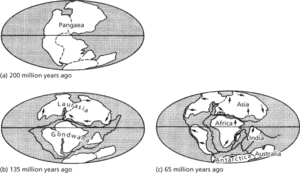The theory that the earth’s continents once formed a single mass and have since moved relative to each other. It was first postulated by A. Snider in 1858 and greatly developed by Alfred Wegener (1880–1930) in 1912. He used evidence, such as the fit of South America into Africa and the distribution of rock types, flora, fauna, and geological structures, to suggest that the present distribution of the continents results from the breaking up of one or two greater land masses. The original land mass was named Pangaea and it was suggested that this broke up into the northerly Laurasia and the southerly Gondwanaland (see illustration). The theory was not accepted for about 50 years by the majority of geologists but during the early 1960s, the seafloor-spreading hypothesis of Harry Hess (1906–69) and the subsequent development of plate tectonics produced a mechanism to explain the drift of the continents.

Continental drift
http://www.ucmp.berkeley.edu/geology/anim1.html Animation of continental drift during the earth’s history
Hypothesis proposed around 1910 to describe the relative movements of continental masses over the surface of the Earth. A major theorist of continental drift, and certainly the one who gave the hypothesis scientific plausibility, was Alfred Wegener (1880–1930). His work was based on qualitative data, but has been vindicated in recent years by the development of the plate tectonics theory, which has provided geologists with a viable mechanism to account for continental movements. See also polar wander.
The theory that continents which are now separate were united in a supercontinent, suggested by Alfred A. Wegener (1916). Wegener’s ideas were vindicated in the mid-1960s when the development of plate-tectonic theory provided a new framework for planetary-scale tectonics, explicable only in terms of continental drift (Harper (2001) Geol. Today 17, 4): Hess (1962), Buddington memorial volume Geol. Soc. Am. 599–620, identified sea-floor spreading as a geologic mechanism to account for Wegener’s moving continents. See Jackson (1993) AAAG 83, 2 on the role played by palaeomagnetic studies in continental drift research.
Dobson (1992) AAAG 82, 187–206 suggests that convection drives circular plate motion while gravity drives lateral motion. Convection currents well up at high-pressure centres, spiral outward, transfer to low-pressure cells, spiral inward, and descend at low-pressure centres. In most instances, upwelling and descent of the asthenosphere occur at opposing plate centres rather than at plate margins. Cells migrate laterally in a global pattern driven by gravity. Sea-floor spreading and subduction occur because of differential rates of lateral plate motion. Bokelmann (2001) Geology 30, 11 believes that movements of the mantle play an important role in driving the plates.
In 2006, NASA scientists released the first direct measurements of continental drift, showing that the Atlantic is gradually widening, and that Australia is receding from South America and heading for Hawaii (Anonymous (2006) New Scientist 192, 2578; p. S24). Silver and Behn (Carnegie Institution) suggest that plate tectonics may have halted at least once, and may do so again. See Pratt (2000) J. Sci. Exploration 14, 4 on the challenges confronting plate tectonics.
- dangling bond
- dangling else
- dangling reference
- Danian
- Daniel K. Inouye Solar Telescope
- Daniell cell
- Daniell, John Frederic
- Daniell weights
- Daniell window
- Danish Society for Theoretical Statistics
- Danjon scale
- Dansgaard, Willi
- Dansgaard–Oeschger (D–O) cycles
- Dansgaard–Oeschger event
- DANTE
- Dante Alighieri (1265–1321)
- Danto, Arthur C. (1924–2013)
- Danton, Georges (1759–94)
- Dantzig, George Bernard (1914–2005)
- dao
- Daphnia
- DAR
- daraf(symbol: F–1)
- Darboux’s theorem
- Darboux’s theorem(Darboux integral)